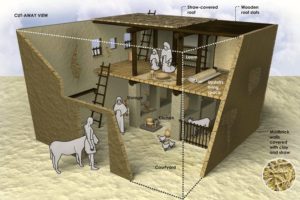In studying the theology of shame throughout the Bible, I’ve been noticing how Jesus came into the world in the midst of shameful company. Since the New Testament culture was a collectivist culture, where honor and status were highly regarded, honor and shame were essential parts of the society at large.
From His lineage, Jesus came from a line associated with those women who were considered sexually promiscuous, which would be seen as shameful such as Tamar, the daughter-in-law of Judah who tricked Judah into sleeping with her so that she would conceive a son. Rahab, the prostitute, who helped Caleb and Joshua in Joshua 2, was also part of Jesus’ lineage (McNish, 9). In a culture where sexual promiscuity would be considered shameful, especially for women, the fact that Jesus came from a lineage associated with these shameful women, makes him associated with those who were shamed.
Also, there was scandal around the conception of Jesus as Mary was seen as being with child even before she was married to Joseph. In this way, even his conception and birth would be seen as shameful in this society. She was a young, teenage girl, pregnant, before she was even married. It would be difficult to explain to her family, friends, and community that she was with child by the Holy Spirit. How believable would that be? Joseph, “being a just man and unwilling to put her to shame, resolved to divorce her quietly” (Matthew 1:19). A public display of Mary’s disgrace would be much worse, even though I’m guessing there were still rumors spreading around as people talked about the fact that she was pregnant out of wedlock. Fortunately, Joseph found out the real deal from Gabriel, took Mary as his wife, and named the child, Jesus.
Then, the first people who first heard about Jesus’ birth were lowly shepherds – people who would be considered as “unclean” in their society, at the bottom of the social ladder. They were simple farm boys, tending animals, and because they were of such lowly place, they would be seen as being without honor, in a place of shame (Stockitt, 35). Yet, the angels appeared to these lowly farm boys, and they were the first visitors to see Jesus (Luke 2:8-20).
Jesus came into the world in a very lowly manner and associated Himself with some very unlikely characters, who would be considered shameful. In this way, Jesus associates with the shameful and outcasts, and inverts the notion of shame, as he turns the places of shame into places of honor. His lineage, which include women who were sexually promiscuous, becomes the lineage of a Savior. The shamed pregnant teenage girl, Mary, becomes the mother of Jesus, who will save His people from their sins. The lowly shepherds are now the first eyewitnesses to Jesus’ birth, now being in an honorable light.
In this way, we can take comfort in knowing that Jesus enters into a world full of shame, and understands it. He understands shame and transforms it. He doesn’t leave us in our own shame, but enters into it with us, as Emmanuel, and transforms it into a place of honor through the victory that is in Him. We no longer have to live bound in shame, but can experience the freedom, honor, and grace that is in Christ.
For reference, see:
- Transforming Shame: A Pastoral Response by Jill McNish
- Restoring the Shamed: Toward a Theology of Shame by Robin Stockitt





5 Comments
Leave your reply.